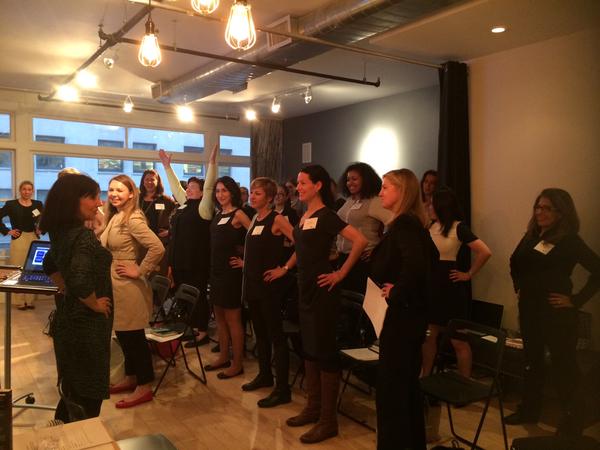When fear of public speaking rears its ugly head, you may discover that your body defaults to one of these four reactions. The good news is that you don’t have to let fear overtake you.
Press Release: Diane DiResta and Pete Mockaitis’ course ranks in the Top 20 Most Popular Courses on LinkedIn.
Speaking Confidently and Effectively, a LinkedIn learning audio course by Pete Mockaitis and Diane DiResta made the Top 20 Most Popular Courses on LinkedIn. The course is hosted by Podcaster and Consultant, Pete Mockaitis and communications expert Diane DiResta, CSP, and author of Knockout Presentations.
The 1 Trick to Blast Through Speaking Fear
The Neuroscience of Instant Confidence
3 Strategies to Conquer Public Speaking Fear
Creating Fireworks on Stage
Losing Your Train-of-Thought
No Sweat! Get Control of Public Speaking Nerves
Three people called me this week because their public speaking fear is holding them back. It's affecting their brand, their reputation, and their career advancement. It's causing them to remain quiet in meetings and to decline speaking opportunities. It’s time to knock out the fear of public speaking! Public speaking is no different from any other fear and you can kick the habit long before you kick the bucket.
Public Speaking is Going to the Dogs
 It's the Dog Days of August and public speaking is going to the dogs - in a good way. Animals, especially dogs, have been used in pet therapy programs for years. Research shows that pets can help lower blood pressure, and reduce anxiety. Bonnie Auslander, who specializes in business communication, decided to use dogs to help reduce public speaking anxiety in front of an audience.
Knowing that dogs are successfully used in pet therapy, Auslander applied the idea to speaking anxiety. The sessions were part of a pilot program at American University. They recruited 12 canines who were chosen for their calm personalities. Nervous business students were paired with a friendly dog.
It's the Dog Days of August and public speaking is going to the dogs - in a good way. Animals, especially dogs, have been used in pet therapy programs for years. Research shows that pets can help lower blood pressure, and reduce anxiety. Bonnie Auslander, who specializes in business communication, decided to use dogs to help reduce public speaking anxiety in front of an audience.
Knowing that dogs are successfully used in pet therapy, Auslander applied the idea to speaking anxiety. The sessions were part of a pilot program at American University. They recruited 12 canines who were chosen for their calm personalities. Nervous business students were paired with a friendly dog.
Did it work? The evidence was anecdotal. The students reported that looking at dogs made them smile.
True confession: When I was starting out as a public speaker, I would place stuffed animals in chairs and would practice my speech as well as my eye contact. The only downside was when my husband walked into the room and saw me talking to a bunch of chairs.
The idea was to mentally remove the negative image of a scary audience and to replace it with something or someone who is accepting.
While we don't know if this experiment in reducing speech anxiety will transfer to a human audience, it can't hurt. The dogs allow the public speakers to "feel the love", and it's a win win. The public speaker reduces anxiety and the canines get undivided attention.
So I guess it's true. Every dog has it's day.
The Fear Worse Than Public Speaking
 Public speaking is not the top fear. Don't get me wrong. I work with clients all the time to build their confidence so that they can express their ideas. Speaking enables leaders to influence, build relationships, and advance their careers. It's one of the most powerful business and personal skills with far reaching impact.
But public speaking fear is a temporary obstruction. It can be overcome. However, there is another fear that is much greater. It's slowly creeping into our culture.
Public speaking is not the top fear. Don't get me wrong. I work with clients all the time to build their confidence so that they can express their ideas. Speaking enables leaders to influence, build relationships, and advance their careers. It's one of the most powerful business and personal skills with far reaching impact.
But public speaking fear is a temporary obstruction. It can be overcome. However, there is another fear that is much greater. It's slowly creeping into our culture.
It's the loss of freedom of speech.
Today, as we celebrate Independence Day, I heard a disturbing report on a television news segment. The University of North Carolina published a guidebook for employees on how to avoid micro aggression. They listed words that should not be used in conversation. Here are a few:
Don't say:
- Christmas Vacation because it could insult someone who practices a different religion
- Wife/Girlfriend or Husband/Boyfriend because it discriminates against other sexual preferences. (So do I deny I'm married ?)
- Round of Golf because some people can't afford to play (Have they not heard of municipal courses?)
- I Love Your Shoes because that's discriminating against women. (I have never met a woman who was insulted when I complimented her shoes).
ARE THEY KIDDING? What kind of craziness is this? Who could take this seriously? What great material for Saturday Night Live.
I certainly don't mean to single out UNC. There are other universities that actually have designated free speech zones. REALLY? The first amendment of the Bill of Rights grants freedom of speech not in geographic zones but everywhere. The purpose was to limit the power of government and now we have universities telling us what we can say.
The comedian, Jerry Seinfeld stopped performing at colleges because he got tired of political correctness. Where is our sense of humor?
Whoever controls language controls thought. And that's scarier than any fear of speaking in public. This July 4th, let's give thanks for freedom of speech and have the confidence to speak out.
Happy July 4th !


Re-Launch of “Give Fear the Finger”
FOR IMMEDIATE RELEASE March 2016
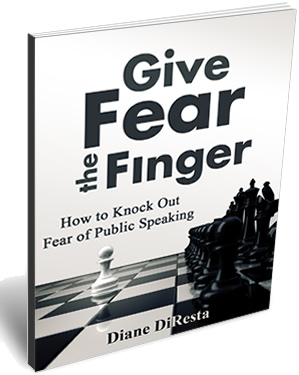 DiResta Communications Recognizes International Women’s Day with Re-Launch of “Give Fear the Finger”
DiResta Communications Recognizes International Women’s Day with Re-Launch of “Give Fear the Finger”
Diane DiResta, author, speaker and owner of DiResta Communications honors the 2016 theme for International Women’s Day—Gender Equality
New York City, NY: “International Women’s Day is a time to reflect on progress made, to call for change and to celebrate acts of courage and determination by ordinary women who have played an extraordinary role in the history of their countries and communities.” The 2016 theme is “Planet 50-50 by 2030: Step It Up for Gender Equality.”
Diane DiResta, in keeping with this theme, is relaunching her latest book, Give Fear the Finger: How to Knock out Fear of Public Speaking and making it available for only $.99 for the rest of the month, starting with International Women’s Day.
Give Fear the Finger shows women (and men) how to never be nervous again. Diane teaches the reader the secrets to being confident and fearless whether speaking to one or 1000. The interactive ebook shows how to stand up to fear and command the platform. Gifted speakers are born but effective speakers are made. Speaking is the new competitive advantage and levels the playing field for women. It gives them visibility they might not access and allows them to have a platform. Speaking let women celebrate their social, economic, cultural and political achievement.
Diane DiResta, who grew up on military bases around the world, began her career as a speech pathologist and now travels internationally teaching interpersonal communications and presentation skills. She traveled to Russia to speak to women entrepreneurs and teaches public speaking in countries like Tanzania, Africa; Bermuda, Brazil, Egypt, Spain and the UK. Diane’s mission is “empowering through the spoken word.”
About Diane DiResta, CSP
Diane DiResta is the founder and CEO of DiResta Communications, Inc, a New York City-based communications skills consultancy serving business leaders who want to communicate with greater impact – whether one-to-one, in front of a crowd, or from an electronic platform. DiResta is a certified speaking professional, a designation held by 12% or professional speakers nationwide. She's also the author of the ebook Give Fear the Finger: How to Knock Out Fear of Public
Speaking and Knockout Presentations, an Amazon.com best seller and widely used text in College business communication courses, entrepreneurship, and more. Celebrated for her inspirational message and inviting presentation style, Diane draws from her knowledge and expertise to engage and motivate her audiences to become the change agents in their own lives and businesses.
For additional information on Diane visit her website - http://diresta.com
To order a copy of Give Fear the Finger for $.99 (beginning Tuesday, March 8) - http://amzn.to/1Y3Bo6k
To schedule an in interview with Diane, contact her publicist, Sandy Lawrence
sandy@perceptivepublicrelations.com
281-989-8892 (Cell)
Is Amy Cuddy's Wonder Woman Pose A Fraud?
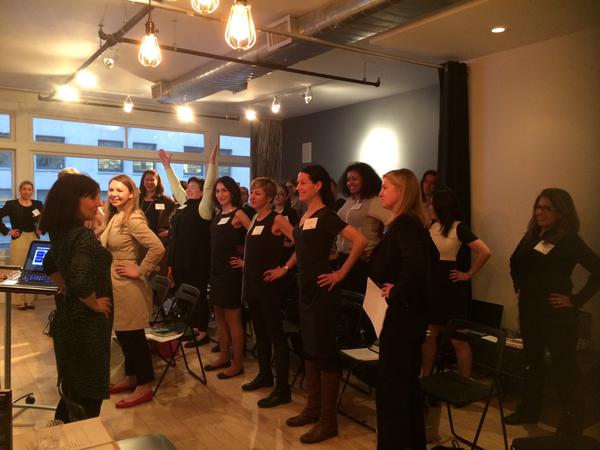 My colleague TJ Walker challenged the validity of Harvard professor, Amy Cuddy's power pose. Amy Cuddy has one of the most popular youtube videos on body language. She advises people to adopt the Wonder Woman pose (hands on hips) to feel powerful when speaking in public. In TJ's twitter post today, he disputes this claim and calls it a fraud.
Here's my opinion. The power pose was recommended to assuage public speaking fear. It's based on neuroscience research and when this pose is held for 2 minutes, there is an increase in testosterone. Higher levels of the hormone, testosterone, are found in those who are risk takers.
My colleague TJ Walker challenged the validity of Harvard professor, Amy Cuddy's power pose. Amy Cuddy has one of the most popular youtube videos on body language. She advises people to adopt the Wonder Woman pose (hands on hips) to feel powerful when speaking in public. In TJ's twitter post today, he disputes this claim and calls it a fraud.
Here's my opinion. The power pose was recommended to assuage public speaking fear. It's based on neuroscience research and when this pose is held for 2 minutes, there is an increase in testosterone. Higher levels of the hormone, testosterone, are found in those who are risk takers.
What was novel was that there was Harvard research backing up her claims. Do I think she's a fraud? No. Unless the research is flawed, it's helpful to have a technique to increase confidence. And there is a body language of confidence. The mind-body connection is widely accepted.
However, as an executive speech coach who works with women leaders and male executives, I don't claim that this one pose is a panacea for public speaking fear, nor does it make you a knockout presenter. TJ makes several good points. Amy Cuddy had a compelling story, a strong structure to her speech, and good visuals. I always tell my clients that great delivery sits on great structure. Your presentation delivery is only as good as your organization. Public speaking success is 90% preparation and 10% delivery.
A client recently hired me for four hours to work on a 15 minute high stakes presentation. That did not include the time she spent with the graphic designer.
So to feel confident, the first step is preparation, planning, and a good, strong message. Presenters need to master their minds as well as their skill set. Does it help to use the power pose? Probably. I teach it to audiences. It makes them feel powerful. But it's not the whole story. There are other physical skills I give them. But I do believe that the mind affects the body and the body affects the mind.
So as long as presenters prepare and practice their message, why not strike a pose and feel powerful?
https://www.youtube.com/watch?v=Ks-_Mh1QhMc
Is Public Speaking Fear Good for You?
 Fear of speaking may be something people escape by avoiding speaking in public. But it just may be that the fear can be beneficial. Sociologist Margee Kerr, author of Scream: Chilling Adventures in the Science of Fear, noticed a relationship between fear and laughter.
After watching people go through a haunted house, she noted that their screams would turn to laughter. Fear is not a separate state as most people believe, but shares much with other states such as surprise, excitement, and joy. How this arousal state gets interpreted depends on context.
Fear of speaking may be something people escape by avoiding speaking in public. But it just may be that the fear can be beneficial. Sociologist Margee Kerr, author of Scream: Chilling Adventures in the Science of Fear, noticed a relationship between fear and laughter.
After watching people go through a haunted house, she noted that their screams would turn to laughter. Fear is not a separate state as most people believe, but shares much with other states such as surprise, excitement, and joy. How this arousal state gets interpreted depends on context.
As for public speaking, one person may experience an adrenaline rush as putting them in a readiness state; another may experience sheer terror. According to Kerr, people push themselves to feel the "...exhilaration, fear, and eventual satisfaction that comes once the threat has passed." Once the fight is over, this can result in a boost of confidence. She explains that the nature of fears are a product of time and place and that we respond to some threats faster than others.
While screams and laughter may be experienced similarly in the brain, most of us perceive these emotions as being very different. The good news is fear of public speaking can be managed and even conquered. Some of the public speaking fear remedies include: desensitization, breathing techniques, mindfulness meditation, and skills practice. Once you shift your mind set, you'll change the way you think about speaking in public.Your fear may haunt you, but don't try too hard to fight your speaking anxiety. That arousal state may just give you a natural high.
3 Magic Words that Kill Public Speaking Fear
 Did you ever wonder if there was an Aladdin's Lamp for public speaking? All you would need to do is ask the Genie for the magic words to eliminate fear of public speaking or performance anxiety. Just like the eternal search for the fountain of youth, people still yearn for that elixir, potion, or formula that will make their nervousness vanish.
What I've discovered is that the words you speak have the power to transform how you think. It's not what you say but how you think about your fear. A number of years ago I spoke to a group of company leaders. They, like everyone else, were nervous about public speaking. At one point I looked them straight in the eye and made a statement. After the training seminar, people told me that those words were very powerful and changed how they thought about public speaking.
Did you ever wonder if there was an Aladdin's Lamp for public speaking? All you would need to do is ask the Genie for the magic words to eliminate fear of public speaking or performance anxiety. Just like the eternal search for the fountain of youth, people still yearn for that elixir, potion, or formula that will make their nervousness vanish.
What I've discovered is that the words you speak have the power to transform how you think. It's not what you say but how you think about your fear. A number of years ago I spoke to a group of company leaders. They, like everyone else, were nervous about public speaking. At one point I looked them straight in the eye and made a statement. After the training seminar, people told me that those words were very powerful and changed how they thought about public speaking.
Fast forward to a coaching client who was afraid to speak up in her class. She even thought about dropping out of law school because she was so nervous about public speaking. I told her the same thing I told every public speaker. And then it happened. She started to think differently after I shared those famous words with her. She graduated from law school and went on to give presentations without fear.
Most recently, a former client called me for a refresher. She told me her manager noticed a big improvement in her presentation and the way she interacted with clients. He offered her the refresher coaching session to prepare for their upcoming high stakes presentation. During the meeting, my client shared with me that the words I said to her truly changed how she thought about presentations and public speaking. Are the words really magical? No! The words themselves contain nothing magical. What the words did was reframe the way people were thinking about their fear. They were viewing public speaking through a negative frame and that triggered anxiety.
Even though I'm a seasoned professional speaker, I found myself getting nervous the day before a presentation. It was a 10 minute spotlight for the National Speakers Association. I confided to my friend that I was a nervous wreck. I couldn't wait for it to be over. My friend grabbed me by the shoulders and said, "Diane, don't do that to yourself. You're not nervous. You're energized." So I went home and recited my new mantra: "I'm energized. I'm energized." The next morning I gave my speech and it was a success. Words do make a difference.
The 3 magic words have made an impact on so many people. I think it is time I share them with you. So what are the 3 Magic Words that help people face their fear?
"It's About Them."
When I speak to audiences of nervous presenters, I tell them, "Get over yourself. It's not about you. It's about them." What they've come to realize is that at the very core of public speaking nervousness is a feeling of being self-centered. That's right. If you focus on the fear, you're thinking about yourself. If you think about what the audience wants and needs, you're coming from a place of service.
Language reflects thought. Change your language and you'll change your thinking. The next time anxiety occupies your mind, change your focus. Tell yourself, "It's about them."
What have you said to yourself to change your thinking?
What's Triggering Your Public Speaking Fear?
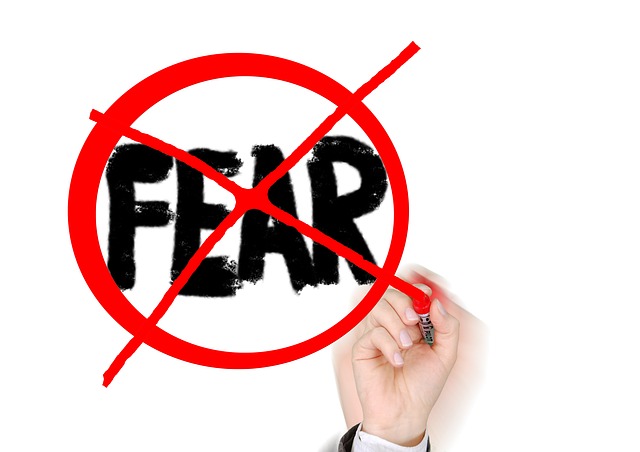 We've all been there - the racing heart, the sweating palms, the cotton mouth. Many clients call me because they're nervous or experiencing public speaking panic. The mere thought of public speaking can trigger anxiety in some presenters.
May is Better Speech and Hearing Month and it's a good time to assess the state of your speaking skills.
We've all been there - the racing heart, the sweating palms, the cotton mouth. Many clients call me because they're nervous or experiencing public speaking panic. The mere thought of public speaking can trigger anxiety in some presenters.
May is Better Speech and Hearing Month and it's a good time to assess the state of your speaking skills.
Ask yourself these questions:
- What do I see when I think of myself speaking?
- What do I say to myself?
- How do I think I'll feel when I finish my speech?
I would bet a lot of money that the answers to those questions are negative. The act of public speaking is neutral. We charge it with anxious energy by the way we think. Successful speakers know that confidence begins in the mind.
So in honor of Better Speech and Hearing Month, resolve to watch this public speaking affirmations video everyday. The only thing that's triggering your public speaking fear is you.
What To Do When You Bomb On Stage
She had always dreamed of being a keynote speaker, and now that moment was here. It was an industry conference and this would be good exposure. She commanded the stage with all the confidence and gravitas of a professional speaker. Her presentation opening was polished and rehearsed, as she showed the audience what she could do. Then, something happened. She lost her voice. No, not her volume. She lost her message!
She froze with a long pause that got longer and longer. At some point, the audience knew from her eyes that this silence was not intentional.The crowd encouraged her with soft mantras. "You go, girl." "You can do it." Finally, she was back in her body and demanded to speak for the remaining two minutes. She grabbed the moment with gusto but this presentation was not her shining moment.
At a women's event, a male stylist was asked to speak about his skin care line. He started off well and then 5 minutes into the talk he excused himself and left the building. Fear got the better of him.
More typical, is the sales presenter who drones on when the prospect is ready to buy. Instead of closing, he covers everything in the deck and talks his way right out of the sale!
So what do you do when you know you're bombing?
1. Take stock and pivot. Quickly assess why it's not going well. Do they seem bored? Then try to engage the audience with a question.
In the case of the sales presentation, if you get a yes, fast forward to the close.
If it's the wrong topic for the meeting, stop, acknowledge the elephant in the room, and be willing to facilitate a discussion, or agree to reschedule the meeting.
2. Breathe. Don't go into panic mode when your brain freezes. You need to get back into your body. Focusing on your breath will help you remain calm. Smile.
3. Summarize. If you go blank, simply summarize the story or material you just presented. This will buy you time.
4. Use a pattern interrupt. One presenter who was behind the lectern, lost her place in the notes. So she did something unexpected. She took out her glasses and slowly adjusted them on her face. This gave her time to find her place. The audience never knew she was lost.
5. Ask for help. I once was on a panel and had a word retrieval issue. I asked the audience, "What is the word I'm looking for?" and then thanked them for their help. No big deal.
6. Pull out your one-liners and come back to the moment. If brain freeze is your fear, plan a number of lines you can use. You can refer to your "senior moment". Comedian Johnny Carson used this technique when a joke didn't get a laugh. He would acknowledge the joke that "just died."
As in sports and politics, you don't always win. Sometimes you win, and sometimes you learn. But you can always recover with grace.
Watch this video - Plan a Recovery Strategy:
And this one - Watch my blooper recovery!
The Secret to Public Speaking Confidence
Dream Big, Execute Small. That was the headline I saw in a recent article. It was addressed to entrepreneurs but it made me think of how true this is for public speakers. You have the dream of one day being a confident public speaker. You yearn for the day that you can stand in front of a group, connect with the audience, remember your message, and make an impact. You hear the thunderous applause and the nodding heads in your imagination. That's the end zone. But getting there seems overwhelming. And this is where most people quit. Some presenters lower their expectations for themselves and only present one-on-one or in safe situations. Others avoid public speaking at all costs because they don't think they can ever succeed.
The reason for the avoidance is a feeling of overwhelm.Nobody goes from zero to 100 in a day. Even the great and gifted speakers spent years studying their craft. The way to get to the goal of confident public speaking is to dream big and execute small.
How do you do this? First start with your vision.
- How do you want to be perceived?
- What will the listeners be saying after your presentation?
- How will you feel after your talk?
Next, break down your goal into small steps. I find that many people who are nervous about public speaking don't know the skills of confidence. You can get learn the secrets to confidence by reading about presentation skills and overcoming fear of public speaking. Visit youtube for instructional videos that will demonstrate each skill. Take a class in public speaking.
Next, volunteer to speak and start small. Redo your voicemail message. Yes, leaving a voicemail is public speaking. Participate in a conference call presentation, a podcast, or a webinar. This will reduce nervousness because you'll be sitting and you won't see the listeners. Then you'll be ready for a face-to-face presentation. But start small. Offer to speak for five minutes as a panelist. When you're ready for the next level, you don't have to go it alone. Ask for a co-presenter. As you're standing in front of the room you'll be less nervous when you and your partner can "tag team" the presentation.
Still not ready to be the main speaker? No problem. Ask to be interviewed on the platform. You can sit on stage while the moderator or emcee asks you questions This allows you to be the subject matter expert without the stress of giving a speech. Another alternative is to plan a Q&A discussion. In place of formal presentation, you can invite the audience to bring questions and you can have a lively question and answer interaction.
Once you get your speaking "sea legs" you'll be ready to step up and take center stage.Effective public speaking is a journey. So give yourself time. Dream big and execute small.
What will you do to take the first step on your public speaking journey?
Overcoming Fear of Public Speaking, Part II
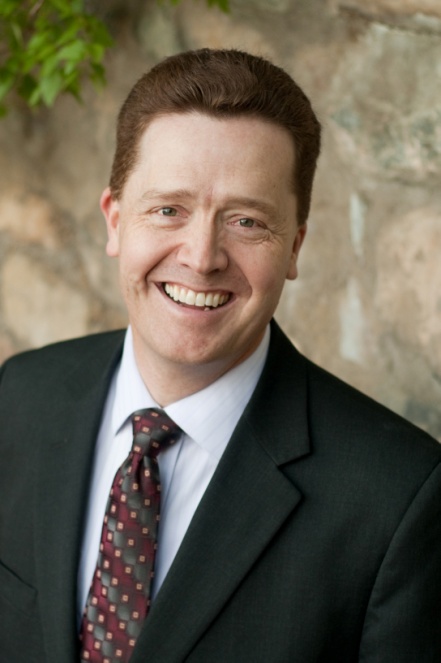 Guest blogger Dr. Paul Jenkins works with organizations and individuals to establish and maintain habitual patterns of positive perception and focus that increase happiness, engagement, productivity, profit, and ultimate achievement of professional and personal life missions.
Two things create – and cure – anxiety.
Guest blogger Dr. Paul Jenkins works with organizations and individuals to establish and maintain habitual patterns of positive perception and focus that increase happiness, engagement, productivity, profit, and ultimate achievement of professional and personal life missions.
Two things create – and cure – anxiety.
The brain and the mind.
In our previous post, Overcoming Fear of Public Speaking, Part I, we addressed the brain component, and how to calm the fight or flight response. The mind, on the other hand, is the ‘you’ inside that does the worrying, fretting, thinking, planning – and succeeding.
The mind is commonly thought of as having two primary parts – the conscious and the subconscious. The conscious is the part you are aware of. The subconscious is where the trouble is because you are not aware of it. The subconscious has a habit of asking, “What If?” The subconscious has a another habit of answering its own questions. The default subconscious answer to the What If question is:
You can’t handle that!
This creates a threat for the limbic system and triggers the fight or flight response.
You can feel the physical onset of anxiety – the fight or flight response – tightness in the chest, harder to breathe, heart pounds, sick feeling. This is caused by the chemical brain response to the subconscious default answer to What If.
Toolbox - Answer The What If Question
- Bring the What If question to the conscious mind
- Answer truthfully and intentionally
- Notice the fearful avoidant response and do it anyway
- Practice, practice, practice
When you get to the answer that you can handle it, your limbic system calms down and allows you to begin thinking again. The thinker solves the problem. Bring the What If up from the dark basement and solve it in the light.
You don’t have to want what you fear, just to get to the point that you know you could handle it.
The What If question itself strikes fear into the heart of many. A prominent undertaker commonly tells his clients when they are making pre-arranged funeral plans, "Thinking and talking about death won't kill you." In the same sense, taking on the What If question won't cause the feared thing to happen. Avoiding the question seeds more anxiety. Answering it truthfully, consciously, and intentionally frees the subconscious to let go of it.
A client shared this quotation with me: “Today is the tomorrow that you were afraid of yesterday.” Here it is, and there you are still handling everything as it comes. At the root of every fear is the same belief – that I can’t handle it. Nothing could be farther from the truth – you have already handled absolutely everything so far, and that will not be changing. Keep moving forward and know that you can handle it!
Remember this – You can handle anything that comes up in your life.
Haven’t you already handled everything so far?
About the Author
Dr. Paul Jenkins works with organizations and individuals to establish and maintain habitual patterns of positive perception and focus that increase happiness, engagement, productivity, profit, and ultimate achievement of professional and personal life missions.
With two decades of experience as a professional psychologist, Dr. Paul (as he is known to clients and his audiences) lays out the how and the why behind the art and science of being constructive in an often destructive environment. It is like having an owner’s manual for your brain – one you can actually read, understand, and apply. You understand your own mind and improve its functioning on purpose.
His deeply thoughtful writing, engaging and fun keynote addresses, powerfully practical breakout seminars, individual and corporate coaching and counseling are profound and simple. His clients, readers, and audiences get an iron grip on powerful Pathological Positivity principles that make an immediate difference in their personal and professional lives.
Overcoming Fear of Public Speaking, Part I
 Guest blogger Dr. Paul Jenkins works with organizations and individuals to establish and maintain habitual patterns of positive perception and focus that increase happiness, engagement, productivity, profit, and ultimate achievement of professional and personal life missions.
Guest blogger Dr. Paul Jenkins works with organizations and individuals to establish and maintain habitual patterns of positive perception and focus that increase happiness, engagement, productivity, profit, and ultimate achievement of professional and personal life missions.
What is your greatest barrier to success, joy, great relationships?
Fear and anxiety.
Would you like to end the fear, anxiety and worry that interferes with your relationships and get in the way of your success and joy?
Two things create – and cure – anxiety.
The brain and the mind.
When you understand the interplay between the brain and the mind, then you are in a perfect position to understand the secret to overcoming fear, anxiety, and worry.
Your brain is not your mind any more than your liver is your mind. Your brain is a part of your body. It is a specialized group of cells that performs a specific function. Your brain is an organ in your body – your mind does the thinking. The answer to your anxiety is understanding what the brain is doing, and steering your mind a different direction.
Understanding and applying a few basic principles in both of these areas makes an
immediate and lasting difference in my clients breaking free from anxiety and moving forward with power in their lives. The short version: Get the brain to calm down and get the mind to come up with new answers.
The brain is designed to respond to threat in a predictable way. Part of its job is to keep you safe and alive. Because of this important job, the brain kicks into what we collectively refer to as the fight or flight response any time a threat is detected. This is true for both real and perceived threats. Chemicals are released into the blood stream which quicken the heart, speed up the breathing, and empower muscles to react with more power and speed. There is also a shut-down of higher cognitive functioning. Contemplating philosophy does not serve you well during an attack from a ferocious lion.
Taming the fight or flight response starts with switching the brain back to thinking mode. Can you imagine installing a switch in your brain that shuts down the fight or flight response and turns the thinking back on?
Breathing exercises provide a switch in your brain. The fight or flight response causes alterations to your breathing (it gets rapid and shallow). By taking intentional control over this typically automatic process, you can directly affect the fight or flight response at a brain level.
Toolbox - Conscious and Focused Breathing - Practice Protocol
- Choose a time and place where you can be undisturbed for 5-10 minutes.
- Assume a comfortable sitting or lying position.
- Breathe in through your nose, making it a point to gently stretch your lungs.
- Hold for 10 to 15 seconds – feel the stretch.
- Slowly exhale through your mouth. Blow like you are blowing out birthday candles. Restrict the flow somewhat. Push it out. It should take you about twice as long to exhale as it took to inhale. Normally when you exhale, you leave some air in your lungs; try to push it all out.
- Repeat steps three through five.
- Notice the feeling of calm relaxation you feel as you complete the exercise. This is your brain switching from fight/flight to rational/think mode.
Do this practice exercise for 3-5 repetitions, 3 times a day, for 5 days.
As you get better at it, a simpler form of this technique can be used in the moment when anxiety attacks. One intentional breath makes a big difference. This effectively calms the brain's fight or flight response.
Stay tuned for Part II of Dr. Paul Jenkins' guest blog post, Overcoming Fear of Public Speaking.
About the Author
Dr. Paul Jenkins works with organizations and individuals to establish and maintain habitual patterns of positive perception and focus that increase happiness, engagement, productivity, profit, and ultimate achievement of professional and personal life missions.
With two decades of experience as a professional psychologist, Dr. Paul (as he is known to clients and his audiences) lays out the how and the why behind the art and science of being constructive in an often destructive environment. It is like having an owner’s manual for your brain – one you can actually read, understand, and apply. You understand your own mind and improve its functioning on purpose.
His deeply thoughtful writing, engaging and fun keynote addresses, powerfully practical breakout seminars, individual and corporate coaching and counseling are profound and simple. His clients, readers, and audiences get an iron grip on powerful Pathological Positivity principles that make an immediate difference in their personal and professional lives.
Give Fear the Finger-In Search of the Confidence Spot
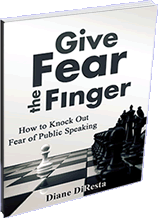 FEAR means False Evidence Appearing Real. I once said that to a group of people and a man in the audience retorted, "That's your definition? My definition is 'Forget everything and run!'" (That's the clean version. He actually used another F word).
But isn't it true? We abandon our rational mind and allow the amygdala or reptile brain to take over. This is the place where fear resides. Our eyes first scan for threat. For many public speakers, an audience of strangers is threatening. And that puts them in a state of fear. I discovered that nervous public speakers live in the future of wild imaginings. They focus on what could go wrong. "I hope I don't trip." "What if I lose my train-of-thought?"
FEAR means False Evidence Appearing Real. I once said that to a group of people and a man in the audience retorted, "That's your definition? My definition is 'Forget everything and run!'" (That's the clean version. He actually used another F word).
But isn't it true? We abandon our rational mind and allow the amygdala or reptile brain to take over. This is the place where fear resides. Our eyes first scan for threat. For many public speakers, an audience of strangers is threatening. And that puts them in a state of fear. I discovered that nervous public speakers live in the future of wild imaginings. They focus on what could go wrong. "I hope I don't trip." "What if I lose my train-of-thought?"
Confident public speakers live in the present. They focus on the message and engage the audience. They know how to access their pre-frontal cortex, the part of the brain responsible for rational thinking.
Research shows that CONFIDENCE TRUMPS COMPETENCE. This explains why the confident person who knows less than you, gets promoted. Yes, confidence accounts for more success than knowledge or skills. Many years ago I was bilked out of $30,000 dollars from my bank account. (This was before online banking). Using a fake check, the perpetrator approached the teller in every branch and cashed the check made out to his name. When the detective questioned the bank tellers, they remembered him as "very smooth, confident." Luckily, the bank replaced my funds but we never found the culprit. He may not have been on a stage, but his platform was a teller's window. He inspired trust with his confidence.
The meaning of the word confidence comes from "con" meaning "from" and "fidere" meaning "to trust." It seems that confidence comes from trusting yourself and trusting others. A confident public speaker has a sense of trust-in the message, the audience and oneself.
How do you gain trust if you approach the platform and feel fear? You give fear the finger. But not in the way you think!
My new ebook will show you a way to short circuit anxiety by activating a special spot that few people know. Give Fear the Finger is filled with exercises, tips and techniques to move you from fear of public speaking to confidence on any platform.
Avoiding public speaking is career suicide. You no longer have to submit to fear. Confidence is closer than you think. It's right there in your hands. And it's available now. You can be confident and take center stage in your career and your life.


